Widgets
In this section, we will introduce basic widgets in wxPython. Each widget will have a small code example. Widgets are basic building blocks of an application. wxPythont has a wide range of various widgets. Buttons, check boxes, sliders, list boxes etc.- wx.Button
- wx.ToggleButton
- wx.StaticLine
- wx.StaticText
- wx.StaticBox
- wx.ComboBox
- wx.CheckBox
- wx.StatusBar
- wx.RadioButton
- wx.Gauge
- wx.Slider
- wx.SpinCtrl
wx.Button
wx.Button is a simple widget. It contains a text string. It is used to trigger an action.#!/usr/bin/pythonIn the code example we create a Close button which terminates the application when pressed.
# -*- coding: utf-8 -*-
import wx
class Example(wx.Frame):
def __init__(self, *args, **kw):
super(Example, self).__init__(*args, **kw)
self.InitUI()
def InitUI(self):
pnl = wx.Panel(self)
cbtn = wx.Button(pnl, label='Close', pos=(20, 30))
cbtn.Bind(wx.EVT_BUTTON, self.OnClose)
self.SetSize((250, 200))
self.SetTitle('wx.Button')
self.Centre()
self.Show(True)
def OnClose(self, e):
self.Close(True)
def main():
ex = wx.App()
Example(None)
ex.MainLoop()
if __name__ == '__main__':
main()
cbtn = wx.Button(pnl, label='Close', pos=(20, 30))A
wx.Button widget is created. In the constructor of the widget we provide the label for the button and the position on the panel. cbtn.Bind(wx.EVT_BUTTON, self.OnClose)The EVT_BUTTON event is triggered when we click on the button. We specify the event handler for the event.
def OnClose(self, e):In the OnClose() method we terminate the application with the
self.Close(True)
Close() method. 
Figure: wx.Button
wx.ToggleButton
wx.ToggleButton is a button that has two states. Pressed and not pressed. You toggle between these two states by clicking on it. There are situations where this functionality fits well.#!/usr/bin/pythonWe have red, green and blue toggle buttons and a panel. We change the color of the panel by clicking on the toggle buttons.
# -*- coding: utf-8 -*-
import wx
class Example(wx.Frame):
def __init__(self, *args, **kw):
super(Example, self).__init__(*args, **kw)
self.InitUI()
def InitUI(self):
pnl = wx.Panel(self)
self.col = wx.Colour(0, 0, 0)
rtb = wx.ToggleButton(pnl, label='red', pos=(20, 25))
gtb = wx.ToggleButton(pnl, label='green', pos=(20, 60))
btb = wx.ToggleButton(pnl, label='blue', pos=(20, 100))
self.cpnl = wx.Panel(pnl, pos=(150, 20), size=(110, 110))
self.cpnl.SetBackgroundColour(self.col)
rtb.Bind(wx.EVT_TOGGLEBUTTON, self.ToggleRed)
gtb.Bind(wx.EVT_TOGGLEBUTTON, self.ToggleGreen)
btb.Bind(wx.EVT_TOGGLEBUTTON, self.ToggleBlue)
self.SetSize((300, 200))
self.SetTitle('Toggle buttons')
self.Centre()
self.Show(True)
def ToggleRed(self, e):
obj = e.GetEventObject()
isPressed = obj.GetValue()
green = self.col.Green()
blue = self.col.Blue()
if isPressed:
self.col.Set(255, green, blue)
else:
self.col.Set(0, green, blue)
self.cpnl.SetBackgroundColour(self.col)
def ToggleGreen(self, e):
obj = e.GetEventObject()
isPressed = obj.GetValue()
red = self.col.Red()
blue = self.col.Blue()
if isPressed:
self.col.Set(red, 255, blue)
else:
self.col.Set(red, 0, blue)
self.cpnl.SetBackgroundColour(self.col)
def ToggleBlue(self, e):
obj = e.GetEventObject()
isPressed = obj.GetValue()
red = self.col.Red()
green = self.col.Green()
if isPressed:
self.col.Set(red, green, 255)
else:
self.col.Set(red, green, 0)
self.cpnl.SetBackgroundColour(self.col)
def main():
ex = wx.App()
Example(None)
ex.MainLoop()
if __name__ == '__main__':
main()
rtb = wx.ToggleButton(pnl, label='red', pos=(20, 25))A
wx.ToggleButton widget is created. self.cpnl = wx.Panel(pnl, pos=(150, 20), size=(110, 110))This is a panel whose color we will modify with the toggle buttons.
self.cpnl.SetBackgroundColour(self.col)
rtb.Bind(wx.EVT_TOGGLEBUTTON, self.ToggleRed)The ToggleRed() event handler is called, when we click on the rtb toggle button.
def ToggleRed(self, e):In the ToggleRed() method we react to the fact, that the rtb button was pressed. We figure out the color parts and update the color of the color panel.
obj = e.GetEventObject()
isPressed = obj.GetValue()
green = self.col.Green()
blue = self.col.Blue()
if isPressed:
self.col.Set(255, green, blue)
else:
self.col.Set(0, green, blue)
self.cpnl.SetBackgroundColour(self.col)
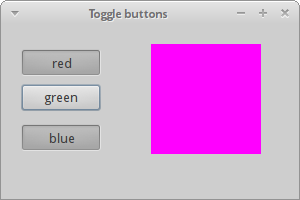
Figure: Toggle buttons
wx.StaticLine
This widget displays a simple line on the window. It can be horizontal or vertical.#!/usr/bin/pythonThe script displays central european countries and their population. The
# -*- coding: utf-8 -*-
import wx
class Example(wx.Frame):
def __init__(self, *args, **kw):
super(Example, self).__init__(*args, **kw)
self.InitUI()
def InitUI(self):
pnl = wx.Panel(self)
font = wx.Font(10, wx.DEFAULT, wx.NORMAL, wx.BOLD)
heading = wx.StaticText(self, label='The Central Europe', pos=(130, 15))
heading.SetFont(font)
wx.StaticLine(self, pos=(25, 50), size=(300,1))
wx.StaticText(self, label='Slovakia', pos=(25, 80))
wx.StaticText(self, label='Hungary', pos=(25, 100))
wx.StaticText(self, label='Poland', pos=(25, 120))
wx.StaticText(self, label='Czech Republic', pos=(25, 140))
wx.StaticText(self, label='Germany', pos=(25, 160))
wx.StaticText(self, label='Slovenia', pos=(25, 180))
wx.StaticText(self, label='Austria', pos=(25, 200))
wx.StaticText(self, label='Switzerland', pos=(25, 220))
wx.StaticText(self, label='5 445 000', pos=(250, 80))
wx.StaticText(self, label='10 014 000', pos=(250, 100))
wx.StaticText(self, label='38 186 000', pos=(250, 120))
wx.StaticText(self, label='10 562 000', pos=(250, 140))
wx.StaticText(self, label='81 799 000', pos=(250, 160))
wx.StaticText(self, label='2 050 000', pos=(250, 180))
wx.StaticText(self, label='8 414 000', pos=(250, 200))
wx.StaticText(self, label='7 866 000', pos=(250, 220))
wx.StaticLine(self, pos=(25, 260), size=(300,1))
tsum = wx.StaticText(self, label='164 336 000', pos=(240, 280))
sum_font = tsum.GetFont()
sum_font.SetWeight(wx.BOLD)
tsum.SetFont(sum_font)
btn = wx.Button(self, label='Close', pos=(140, 310))
btn.Bind(wx.EVT_BUTTON, self.OnClose)
self.SetSize((360, 380))
self.SetTitle('wx.StaticLine')
self.Centre()
self.Show(True)
def OnClose(self, e):
self.Close(True)
def main():
ex = wx.App()
Example(None)
ex.MainLoop()
if __name__ == '__main__':
main()
wx.StatLine makes it look more visually attractive. wx.StaticLine(self, pos=(25, 50), size=(300,1))This is the constructor of the
wx.StaticLine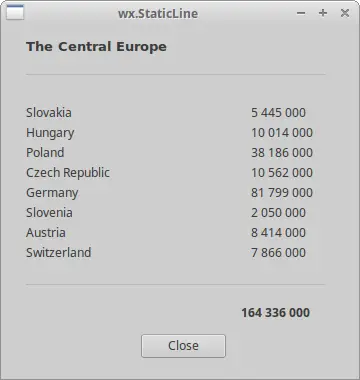
Figure: wx.StaticLine
wx.StaticText
A wx.StaticText widget displays one or more lines of read-only text.#!/usr/bin/pythonIn the example we show two strophes of a Bittersweet song using the
# -*- coding: utf-8 -*-
import wx
class Example(wx.Frame):
def __init__(self, *args, **kw):
super(Example, self).__init__(*args, **kw)
self.InitUI()
def InitUI(self):
txt1 = '''I'm giving up the ghost of love
in the shadows cast on devotion
She is the one that I adore
creed of my silent suffocation
Break this bittersweet spell on me
lost in the arms of destiny'''
txt2 = '''There is something in the way
You're always somewhere else
Feelings have deserted me
To a point of no return
I don't believe in God
But I pray for you'''
pnl = wx.Panel(self)
vbox = wx.BoxSizer(wx.VERTICAL)
st1 = wx.StaticText(pnl, label=txt1, style=wx.ALIGN_CENTRE)
st2 = wx.StaticText(pnl, label=txt2, style=wx.ALIGN_CENTRE)
vbox.Add(st1, flag=wx.ALL, border=5)
vbox.Add(st2, flag=wx.ALL, border=5)
pnl.SetSizer(vbox)
self.SetSize((250, 260))
self.SetTitle('Bittersweet')
self.Centre()
self.Show(True)
def main():
ex = wx.App()
Example(None)
ex.MainLoop()
if __name__ == '__main__':
main()
wx.StaticText widget. txt1 = '''I'm giving up the ghost of loveThis is a string to be shown in the
in the shadows cast on devotion
She is the one that I adore
creed of my silent suffocation
Break this bittersweet spell on me
lost in the arms of destiny'''
wx.StaticText widget. st1 = wx.StaticText(pnl, label=txt1, style=wx.ALIGN_CENTRE)We create the
wx.StaticText widget. The text will be aligned to the center. 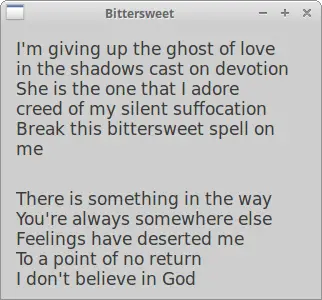
Figure: wx.StaticText
wx.StaticBox
This is a kind of a decorator widget. It is used to logically group various widgets. Note that this widget must be created before the widgets that it contains, and that those widgets should be siblings, not children, of the static box.#!/usr/bin/pythonWe have a
# -*- coding: utf-8 -*-
import wx
class Example(wx.Frame):
def __init__(self, *args, **kw):
super(Example, self).__init__(*args, **kw)
self.InitUI()
def InitUI(self):
pnl = wx.Panel(self)
wx.StaticBox(pnl, label='Personal Info', pos=(5, 5), size=(240, 170))
wx.CheckBox(pnl, label='Male', pos=(15, 30))
wx.CheckBox(pnl, label='Married', pos=(15, 55))
wx.StaticText(pnl, label='Age', pos=(15, 95))
wx.SpinCtrl(pnl, value='1', pos=(55, 90), size=(60, -1), min=1, max=120)
btn = wx.Button(pnl, label='Ok', pos=(90, 185), size=(60, -1))
btn.Bind(wx.EVT_BUTTON, self.OnClose)
self.SetSize((270, 250))
self.SetTitle('Static box')
self.Centre()
self.Show(True)
def OnClose(self, e):
self.Close(True)
def main():
ex = wx.App()
Example(None)
ex.MainLoop()
if __name__ == '__main__':
main()
wx.StaticBox which decorates other four widgets. 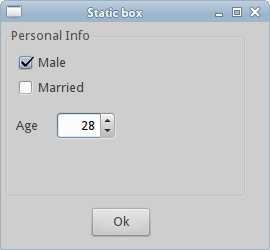
Figure: Static box
wx.ComboBox
wx.ComboBox is a combination of a single line text field, a button with a down arrow image and a listbox. When you press the button, a listbox appears. A user can select only one option from the supplied string list. #!/usr/bin/pythonSelected option from the combo box is shown in the label below.
# -*- coding: utf-8 -*-
import wx
class Example(wx.Frame):
def __init__(self, *args, **kw):
super(Example, self).__init__(*args, **kw)
self.InitUI()
def InitUI(self):
pnl = wx.Panel(self)
distros = ['Ubuntu', 'Arch', 'Fedora', 'Debian', 'Mint']
cb = wx.ComboBox(pnl, pos=(50, 30), choices=distros,
style=wx.CB_READONLY)
self.st = wx.StaticText(pnl, label='', pos=(50, 140))
cb.Bind(wx.EVT_COMBOBOX, self.OnSelect)
self.SetSize((250, 230))
self.SetTitle('wx.ComboBox')
self.Centre()
self.Show(True)
def OnSelect(self, e):
i = e.GetString()
self.st.SetLabel(i)
def main():
ex = wx.App()
Example(None)
ex.MainLoop()
if __name__ == '__main__':
main()
distros = ['Ubuntu', 'Arch', 'Fedora', 'Debian', 'Mint']The combo box will contain this list of strings.
cb = wx.ComboBox(pnl, pos=(50, 30), choices=distros,A
style=wx.CB_READONLY)
wx.ComboBox widget is created. The choices parameter takes a list of strings to display by the combo box. The wx.CB_READONLYstyle makes the strings of the list read-only. cb.Bind(wx.EVT_COMBOBOX, self.OnSelect)When we select an option from the combo box, the EVT_COMBOBOX event is triggered. We plug the OnSelect() event handler to this event.
def OnSelect(self, e):We get the selected item from the combo box and set it to the label.
i = e.GetString()
self.st.SetLabel(i)
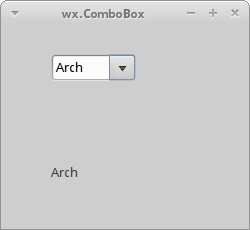
Figure: wx.ComboBox
wx.CheckBox
Awx.CheckBox is a widget that has two states. On and off. It is a box with a label. The label can be set to the right or to the left of the box. If a wx.CheckBox is checked, it is represented by a tick in a box. #!/usr/bin/pythonIn the above example we show or hide the window title with the
# -*- coding: utf-8 -*-
import wx
class Example(wx.Frame):
def __init__(self, *args, **kw):
super(Example, self).__init__(*args, **kw)
self.InitUI()
def InitUI(self):
pnl = wx.Panel(self)
cb = wx.CheckBox(pnl, label='Show title', pos=(20, 20))
cb.SetValue(True)
cb.Bind(wx.EVT_CHECKBOX, self.ShowOrHideTitle)
self.SetSize((250, 170))
self.SetTitle('wx.CheckBox')
self.Centre()
self.Show(True)
def ShowOrHideTitle(self, e):
sender = e.GetEventObject()
isChecked = sender.GetValue()
if isChecked:
self.SetTitle('wx.CheckBox')
else:
self.SetTitle('')
def main():
ex = wx.App()
Example(None)
ex.MainLoop()
if __name__ == '__main__':
main()
wx.CheckBoxwidget. cb = wx.CheckBox(pnl, label='Show title', pos=(20, 20))This is the constructor of the
wx.CheckBox widget. cb.SetValue(True)The title of the frame window is shown by default, so we check the
wx.CheckBox widget with the SetValue()method. cb.Bind(wx.EVT_CHECKBOX, self.ShowOrHideTitle)The EVT_CHECKBOX event is triggered when we click on the
wx.CheckBox widget. The ShowOrHideTitle() event handler is called upon this event. def ShowOrHideTitle(self, e):In the ShowOrHideTitle() method we show or hide the title based on the state of the
sender = e.GetEventObject()
isChecked = sender.GetValue()
if isChecked:
self.SetTitle('wx.CheckBox')
else:
self.SetTitle('')
wx.CheckBox widget. 
Figure: wx.CheckBox
wx.StatusBar
Thewx.StatusBar widget is used to display application status information. It can be divided into several parts to show different kind of information. We can insert other widgets into the wx.StatusBar. It can be used as an alternative to dialogs, since dialogs are ofted abused and they are disliked by most users. We can create a wx.StatusBar in two ways. We can manually create our own wx.StatusBar and call SetStatusBar() method or we can simply call the CreateStatusBar() method. The latter method creates a default wx.StatusBar for us. #!/usr/bin/pythonIn our example, we have a
# -*- coding: utf-8 -*-
import wx
class Example(wx.Frame):
def __init__(self, *args, **kw):
super(Example, self).__init__(*args, **kw)
self.InitUI()
def InitUI(self):
pnl = wx.Panel(self)
button = wx.Button(pnl, label='Button', pos=(20, 20))
text = wx.CheckBox(pnl, label='CheckBox', pos=(20, 90))
combo = wx.ComboBox(pnl, pos=(120, 22), choices=['Python', 'Ruby'])
slider = wx.Slider(pnl, 5, 6, 1, 10, (120, 90), (110, -1))
pnl.Bind(wx.EVT_ENTER_WINDOW, self.OnWidgetEnter)
button.Bind(wx.EVT_ENTER_WINDOW, self.OnWidgetEnter)
text.Bind(wx.EVT_ENTER_WINDOW, self.OnWidgetEnter)
combo.Bind(wx.EVT_ENTER_WINDOW, self.OnWidgetEnter)
slider.Bind(wx.EVT_ENTER_WINDOW, self.OnWidgetEnter)
self.sb = self.CreateStatusBar()
self.SetSize((250, 230))
self.SetTitle('wx.Statusbar')
self.Centre()
self.Show(True)
def OnWidgetEnter(self, e):
name = e.GetEventObject().GetClassName()
self.sb.SetStatusText(name + ' widget')
e.Skip()
def main():
ex = wx.App()
Example(None)
ex.MainLoop()
if __name__ == '__main__':
main()
wx.Frame widget and five other widgets. If we hover a mouse pointer over a widget, its name is shown in the wx.StatusBar. pnl.Bind(wx.EVT_ENTER_WINDOW, self.OnWidgetEnter)The EVT_ENTER_WINDOW event is generated, if we enter the area of a widget.
self.sb = self.CreateStatusBar()A statusbar is created with the
CreateStatusBar() method. def OnWidgetEnter(self, e):Inside the OnWidgetEnter() method we figure out the name of the widget that we enter with the mouse pointer. We set a status text with the
name = e.GetEventObject().GetClassName()
self.sb.SetStatusText(name + ' widget')
e.Skip()
SetStatusText()method. 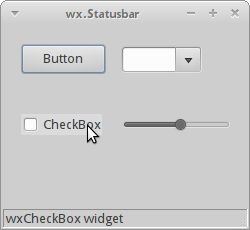
Figure: wx.StatusBar
wx.RadioButton
wx.RadioButton is a widget that allows the user to select a single exclusive choice from a group of options. A group of radio buttons is defined by having the first radio button in the group contain the wx.RB_GROUP style. All other radio buttons defined after the first radio button with this style flag will be added to the function group of the first radio button. Declaring another radio button with the wx.RB_GROUP flag will start a new radio button group. #!/usr/bin/pythonWe have a group of three radio buttons. The state of each of the radio buttons is displayed in the statusbar.
# -*- coding: utf-8 -*-
import wx
class Example(wx.Frame):
def __init__(self, *args, **kw):
super(Example, self).__init__(*args, **kw)
self.InitUI()
def InitUI(self):
pnl = wx.Panel(self)
self.rb1 = wx.RadioButton(pnl, label='Value A', pos=(10, 10),
style=wx.RB_GROUP)
self.rb2 = wx.RadioButton(pnl, label='Value B', pos=(10, 30))
self.rb3 = wx.RadioButton(pnl, label='Value C', pos=(10, 50))
self.rb1.Bind(wx.EVT_RADIOBUTTON, self.SetVal)
self.rb2.Bind(wx.EVT_RADIOBUTTON, self.SetVal)
self.rb3.Bind(wx.EVT_RADIOBUTTON, self.SetVal)
self.sb = self.CreateStatusBar(3)
self.sb.SetStatusText("True", 0)
self.sb.SetStatusText("False", 1)
self.sb.SetStatusText("False", 2)
self.SetSize((210, 210))
self.SetTitle('wx.RadioButton')
self.Centre()
self.Show(True)
def SetVal(self, e):
state1 = str(self.rb1.GetValue())
state2 = str(self.rb2.GetValue())
state3 = str(self.rb3.GetValue())
self.sb.SetStatusText(state1, 0)
self.sb.SetStatusText(state2, 1)
self.sb.SetStatusText(state3, 2)
def main():
ex = wx.App()
Example(None)
ex.MainLoop()
if __name__ == '__main__':
main()
self.rb1 = wx.RadioButton(pnl, label='Value A', pos=(10, 10),We create three radio buttons. The first radio button has the
style=wx.RB_GROUP)
self.rb2 = wx.RadioButton(pnl, label='Value B', pos=(10, 30))
self.rb3 = wx.RadioButton(pnl, label='Value C', pos=(10, 50))
wx.RB_GROUPstyle set. It starts a new radio group. self.rb1.Bind(wx.EVT_RADIOBUTTON, self.SetVal)We bind the EVT_RADIOBUTTON event to the SetVal() event handler.
self.sb = self.CreateStatusBar(3)We create a statusbar with three fields. We set initial text to the statusbar corresponding with the radio button states.
self.sb.SetStatusText("True", 0)
self.sb.SetStatusText("False", 1)
self.sb.SetStatusText("False", 2)
def SetVal(self, e):Inside the SetVal() method we find out the states of the radio buttons. We update the statusbar fields to the current radio button values.
state1 = str(self.rb1.GetValue())
state2 = str(self.rb2.GetValue())
state3 = str(self.rb3.GetValue())
self.sb.SetStatusText(state1, 0)
self.sb.SetStatusText(state2, 1)
self.sb.SetStatusText(state3, 2)
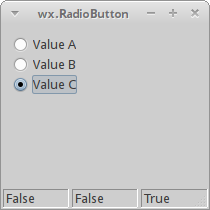
Figure: wx.RadioButton
wx.Gauge
wx.Gauge is a widget that is used, when we process lengthy tasks. It has an indicator to show the current state of a task.#!/usr/bin/pythonWe have a gauge and two buttons. One button starts the gauge, the other button stops the gauge.
# -*- coding: utf-8 -*-
import wx
TASK_RANGE = 50
class Example(wx.Frame):
def __init__(self, *args, **kw):
super(Example, self).__init__(*args, **kw)
self.InitUI()
def InitUI(self):
self.timer = wx.Timer(self, 1)
self.count = 0
self.Bind(wx.EVT_TIMER, self.OnTimer, self.timer)
pnl = wx.Panel(self)
vbox = wx.BoxSizer(wx.VERTICAL)
hbox1 = wx.BoxSizer(wx.HORIZONTAL)
hbox2 = wx.BoxSizer(wx.HORIZONTAL)
hbox3 = wx.BoxSizer(wx.HORIZONTAL)
self.gauge = wx.Gauge(pnl, range=TASK_RANGE, size=(250, 25))
self.btn1 = wx.Button(pnl, wx.ID_OK)
self.btn2 = wx.Button(pnl, wx.ID_STOP)
self.text = wx.StaticText(pnl, label='Task to be done')
self.Bind(wx.EVT_BUTTON, self.OnOk, self.btn1)
self.Bind(wx.EVT_BUTTON, self.OnStop, self.btn2)
hbox1.Add(self.gauge, proportion=1, flag=wx.ALIGN_CENTRE)
hbox2.Add(self.btn1, proportion=1, flag=wx.RIGHT, border=10)
hbox2.Add(self.btn2, proportion=1)
hbox3.Add(self.text, proportion=1)
vbox.Add((0, 30))
vbox.Add(hbox1, flag=wx.ALIGN_CENTRE)
vbox.Add((0, 20))
vbox.Add(hbox2, proportion=1, flag=wx.ALIGN_CENTRE)
vbox.Add(hbox3, proportion=1, flag=wx.ALIGN_CENTRE)
pnl.SetSizer(vbox)
self.SetSize((300, 200))
self.SetTitle('wx.Gauge')
self.Centre()
self.Show(True)
def OnOk(self, e):
if self.count >= TASK_RANGE:
return
self.timer.Start(100)
self.text.SetLabel('Task in Progress')
def OnStop(self, e):
if self.count == 0 or self.count >= TASK_RANGE or not self.timer.IsRunning():
return
self.timer.Stop()
self.text.SetLabel('Task Interrupted')
def OnTimer(self, e):
self.count = self.count + 1
self.gauge.SetValue(self.count)
if self.count == TASK_RANGE:
self.timer.Stop()
self.text.SetLabel('Task Completed')
def main():
ex = wx.App()
Example(None)
ex.MainLoop()
if __name__ == '__main__':
main()
self.timer = wx.Timer(self, 1)We use the
self.count = 0
wx.Timer to execute code at specific intervals. We will update the gauge at those moments. The count variable is used to determine the portion of the task already done. self.gauge = wx.Gauge(pnl, range=TASK_RANGE, size=(250, 25))This is the constructor of the
wx.Gauge widget. The range parameter sets the maximum integer value of the widget. def OnOk(self, e):When we click on the OK button, the OnOk() method is called. We first check if the count variable is within the range of the task. If not, we return from the method. If the task is not yet completed, we start the timer and update the static text.
if self.count >= TASK_RANGE:
return
self.timer.Start(100)
self.text.SetLabel('Task in Progress')
def OnStop(self, e):The OnStop() method is called, when we click on the stop button. We check the conditions for stopping the task. If we have met them, we stop the timer and update the static text.
if self.count == 0 or self.count >= TASK_RANGE or not self.timer.IsRunning():
return
self.timer.Stop()
self.text.SetLabel('Task Interrupted')
def OnTimer(self, e):The OnTimer() method is called periodically after starting the timer. In the method we update the cout variable and the gauge widget. If the count variable is equal to the TASK_RANGE, we stop the timer and update the static text.
self.count = self.count + 1
self.gauge.SetValue(self.count)
if self.count == TASK_RANGE:
self.timer.Stop()
self.text.SetLabel('Task Completed')

Figure: wx.Gauge
wx.Slider
wx.Slider is a widget that has a simple handle. This handle can be pulled back and forth. This way we can choose a specific task. #!/usr/bin/pythonA value selected in the slider is shown in the static text below.
# -*- coding: utf-8 -*-
import wx
class Example(wx.Frame):
def __init__(self, *args, **kw):
super(Example, self).__init__(*args, **kw)
self.InitUI()
def InitUI(self):
pnl = wx.Panel(self)
sld = wx.Slider(pnl, value=200, minValue=150, maxValue=500, pos=(20, 20),
size=(250, -1), style=wx.SL_HORIZONTAL)
sld.Bind(wx.EVT_SCROLL, self.OnSliderScroll)
self.txt = wx.StaticText(pnl, label='200', pos=(20, 90))
self.SetSize((290, 200))
self.SetTitle('wx.Slider')
self.Centre()
self.Show(True)
def OnSliderScroll(self, e):
obj = e.GetEventObject()
val = obj.GetValue()
self.txt.SetLabel(str(val))
def main():
ex = wx.App()
Example(None)
ex.MainLoop()
if __name__ == '__main__':
main()
sld = wx.Slider(pnl, value=200, minValue=150, maxValue=500, pos=(20, 20),A
size=(250, -1), style=wx.SL_HORIZONTAL)
wx.Slider is created. We provide the initial position of the slider with the value parameter and the minimum and maximum slider positions with the minValue and maxValue parameters. The wx.SL_HORIZONTALmakes the slider to be horizontal. sld.Bind(wx.EVT_SCROLL, self.OnSliderScroll)When the EVT_SCROLL event is encountered, the OnSliderScroll() method is called.
self.txt = wx.StaticText(pnl, label='200', pos=(20, 90))The currently selected slider value is displayed in the static text, which we position below the slider.
def OnSliderScroll(self, e):In the OnSliderScroll() method we get the sender of the event. We get the current value of the slider and set it to the static text.
obj = e.GetEventObject()
val = obj.GetValue()
self.txt.SetLabel(str(val))

Figure: wx.Slider
wx.SpinCtrl
Thewx.SpinCtrl widget lets us increment and decrement a value. It has two up and down arrow buttons for this purpose. User can enter a value into a box or increment/decrement it by these two arrows. #!/usr/bin/pythonThe script converts Fahrenheit temperature to Celsius. We use the
# -*- coding: utf-8 -*-
import wx
class Example(wx.Frame):
def __init__(self, *args, **kw):
super(Example, self).__init__(*args, **kw)
self.InitUI()
def InitUI(self):
pnl = wx.Panel(self)
wx.StaticText(self, label='Convert Fahrenheit temperature to Celsius',
pos=(20,20))
wx.StaticText(self, label='Fahrenheit: ', pos=(20, 80))
wx.StaticText(self, label='Celsius: ', pos=(20, 150))
self.celsius = wx.StaticText(self, label='', pos=(150, 150))
self.sc = wx.SpinCtrl(self, value='0', pos=(150, 75), size=(60, -1))
self.sc.SetRange(-459, 1000)
btn = wx.Button(self, label='Compute', pos=(70, 230))
btn.SetFocus()
cbtn = wx.Button(self, label='Close', pos=(185, 230))
btn.Bind(wx.EVT_BUTTON, self.OnCompute)
cbtn.Bind(wx.EVT_BUTTON, self.OnClose)
self.SetSize((350, 310))
self.SetTitle('wx.SpinCtrl')
self.Centre()
self.Show(True)
def OnClose(self, e):
self.Close(True)
def OnCompute(self, e):
fahr = self.sc.GetValue()
cels = round((fahr - 32) * 5 / 9.0, 2)
self.celsius.SetLabel(str(cels))
def main():
ex = wx.App()
Example(None)
ex.MainLoop()
if __name__ == '__main__':
main()
wx.SpinCtrl widget to select a value for the Fahrenheit temperature. self.sc = wx.SpinCtrl(self, value='0', pos=(150, 75), size=(60, -1))We create a
self.sc.SetRange(-459, 1000)
wx.SpinCtrl widget with initial value 0. The SetRange() sets a range of values for the widget. def OnCompute(self, e):When we click on the compute button the OnCompute() method is called. In the body of the method we get the current value from the spin control. We compute the Celsius temperature and set the computed temperature to the static text widget.
fahr = self.sc.GetValue()
cels = round((fahr - 32) * 5 / 9.0, 2)
self.celsius.SetLabel(str(cels))
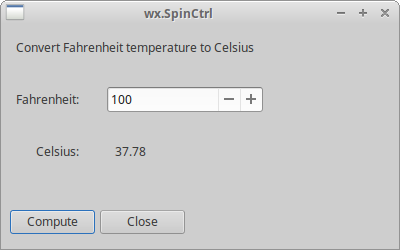
Figure: wx.SpinCtrl
This part of the wxPython tutorial was dedicated to core wxPython widgets.
No comments:
Post a Comment